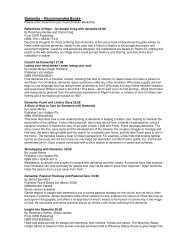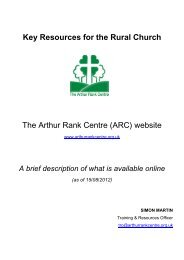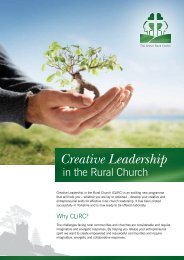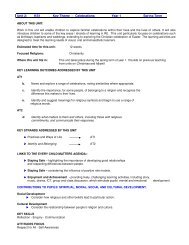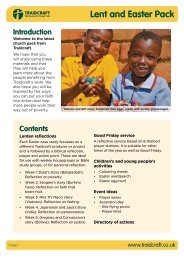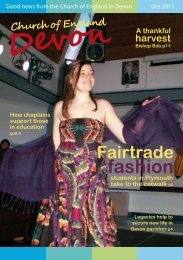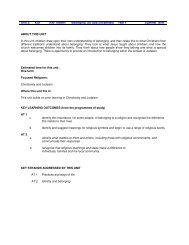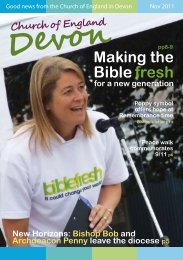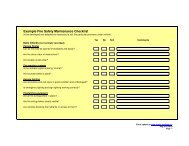Worship, Pilgrimage & Sacred Places
Worship, Pilgrimage & Sacred Places
Worship, Pilgrimage & Sacred Places
You also want an ePaper? Increase the reach of your titles
YUMPU automatically turns print PDFs into web optimized ePapers that Google loves.
Unit 1: KS2 Key Theme: <strong>Worship</strong>, <strong>Pilgrimage</strong> & <strong>Sacred</strong> <strong>Places</strong> Year 3 Autumn TermABOUT THIS UNIT:In this unit children will have the opportunity to study the key features of worship and what worshipmeans to a believer in Christianity and Hinduism. Children will explore the concepts of pilgrimage andsacred places within the contexts of Christianity and Hinduism.Estimated time for this unit:One termFocused Religions:Christianity and HinduismWhere this unit fits in:This unit builds on prior learning on Christianity and Belonging.KEY LEARNING OUTCOMES (from the programmes of study)AT 1AT 2b. Describe the variety of practices and ways of life in religions and understand how these stemfrom, and are closely connected to, beliefs and teachings.e. Consider the meaning of a range of forms of religious expression, understand why they areimportant in religion, and note links between them.b. Respond to the challenges of commitment both in their own lives and within religioustraditions, recognising how commitment to a religion is shown in a variety of ways.e. Reflect on sources of inspiration in their own and others’ lives.KEY STRANDS ADDRESSED BY THIS UNITAT1AT2Practices and ways of lifeIdentity and belongingLINKS TO THE EVERY CHILD MATTERS AGENDABeing Healthy ( Body, Mind and Spirit) – engage with challenging concepts and ideas.Enjoyment and Achievement – promoting pupils’ own ideas and providing opportunities toexplore and reflect on key questions and values.Achieving Economic Well-being – considering how religious and other beliefs lead toparticular actions and concerns.1
CONTRIBUTIONS TO PUPILS SPIRITUAL, MORAL, SOCIAL AND CULTURAL DEVELOPMENTSpiritual development through :- learning about and reflecting upon important concepts,experiences and beliefs which are at the heart of religious and other traditions and practices.Social development through :- investigating social issues from religious perspectives, recognisingdiversity of viewpoint within and between religions, as well as common ground between them.Cultural development through :- considering the relationship between religion and cultures and howreligious beliefs contribute to cultural identity and practices.KEY SKILLSReflection, Enquiry, Empathy and InterpretationKEY ATTITUDESRespect, Open mindedness2
Prior learning Vocabulary ResourcesIt is helpful if children have:Awareness of belonging toa religion and what can belearnt from visiting a placeof worship.Awareness of specialjourneys in differentreligions.In this unit, children will have anopportunity to use words andphrases related to:worshipprayerpilgrimageChristianity:ChurchJerusalemLourdesBernadette.Hinduism:BrahmanmurtipujaartiMandirGanges.www.request.org.ukhttp://rexs.ucsm.ac.uk/re/pilgrimage/hinduism.htmwww.lourdes-france.orgwww.topmarks.co.ukArtefacts that are used in worship –Christianity (paten, chalice)Hinduism ( murti)Christianity photopackHinduism photopack(pub Folens)“Teaching Christianity in the PrimarySchool”“Teaching Hinduism in the Primary School”(DES publications)EXPECTATIONS at the end of this unit:Nearly all can: (at level 1)AT1 b• use some religious words and phrases to recognise and name features of religious lifeand practice.• recall religious stories and recognise symbols, and other verbal and visual forms ofreligious expression.AT2 d• talk about their own experiences and feelings, what they find interesting or puzzling andwhat is of value and concern to themselves and to others.Pupil friendly level descriptions. I can ….• use the right names for things that are special to Christians and Hindus (AT1)e.g. say that is a Church”, or “this is a Mandir” when looking at places of worship.• talk about things that happen to me (AT2)e.g. talk about how I felt when my baby brother or sister was born.3
Many can: (at level 2)AT1 b• use religious words and phrases to identify some features of religion and its importance forsome people• begin to show awareness of similarities in religions• retell religious stories and suggest meaning for religious actions and symbols• identify how religion is expressed in different ways.Pupil friendly level descriptions I can …..• ask about some of the things that are the same for different religious people• ask about what happens to others with respect for their feelingse.g. I can ask and think about how pilgrims feel on a pilgrimageAT2 d• ask, and respond sensitively to, questions about their own and others’ experiences and feelings.• recognise that some questions cause people to wonder and are difficult to answer• recognise their own values and those of others in relation to matters of right and wrongPupil friendly level descriptions I can ….• ask about what happens to others with respect for their feelingse.g. ask and think about how pilgrims feel on a pilgrimageSome children will have progressed further and can: (at level 3)AT1 b• use a developing religious vocabulary to describe some key features of religions, recognisingsimilarities and differences• make links between beliefs and sources, including religious stories and sacred texts• begin to identify the impact religion has on believers’ lives• describe some forms of religious expression.Pupil friendly level descriptions I can …….• describe some of the things that are the same and different for religious peoplee.g. I can say what is the same and what is different about Christian and Hindu placesof worship and pilgrimageAT2 d• identify what influences them, making links between aspects of their own and others’experiences• ask important questions about religion and beliefs, making links between their own and others’responses• make links between values and commitments, and their own attitudes and behaviour.Pupil friendly level descriptions I can …….• compare some of the things that influence me with those that influence other peoplee.g. I can think about and ask questions about worship and pilgrimage and how that influencesbelievers4
Key questionsLEARNING OBJECTIVESPupils should learn:Teaching and Learning Activities Assessment Opportunities Links / points to noteWhat is special toyou?What places arespecial to others?• that we all have differentreasons for valuing things/people. (AT2)• Children sitting quietly .Askchildren to imagine that theyare holding an object that isvery special to them. Thinkabout what does it look like?Who gave it to you? Is itexpensive? How long haveyou had it? Imagine nowgiving that special object tosomeone that you don’t knowvery well. How do you feel ifthey don’t treat it carefully?How do you feel when theobject is returned to you?• Children now asked toimagine that they are goingon a journey to theirfavourite/special place. Theycan take with them as manyfamily and friends as theywant. Where have they‘travelled’ to? Who is withthem? How do they feel?Why?My special objectsVisualisation activity inAppendix 1A quiet visualisation script(From Developing PrimaryRE Series - Pub. RETodayand reproduced with permissionfrom REToday)5
Key questionsLEARNING OBJECTIVESPupils should learn:Teaching and Learning Activities Assessment Opportunities Links / points to noteWhat is special toyou?What places arespecial to others?• that journeys includetriumphs but also difficultiesand that some journeys havea special significance. (AT2)• Introduce to the children thatthey will be going on a journeywhere a choice will need to bemade. Choice 1 – going on aholiday with as much money etcas they want but they must goalone. Choice 2 – going on adifficult journey to find theanswer to a world issues suchas hunger or drought. They cantake as many family and friends/desired objects as they want.• As a class discuss the journeychoices and make a decision.Speaking and listening – fromdiscussions have the childrenunderstood the different types ofjourneys and difficulties withinthose journeys as well as theirspiritual meaning.Difficult journeys could includeanswer to world hunger isengraved in a distant glacier inthe Antarctic . You would havepictures of the location tosupport children’s thinking.Other ideas include trekkingacross a desert, climbing a tallmountain etc.• In mixed ability groups childrento plan journey using planner(see appendix 3 - Our GroupJourney).• As a whole class presentjourneys at end, includingoutcomes and reasons forchoices. Would you participatein a similar journey knowing howdifficult it is? Why/ not?Follow lessonplans fromFestivalMatters –Harvest Y 36
Key questionsWhat is worship?What happens in aChurch, and thewider Christiancommunity?Who are Hindus?LEARNING OBJECTIVESPupils should learn:• that worship is an importantreligious activity and anexpression of faith. (AT1)• that worship can be acommunal or individualactivity. (AT1)• that worship can beexpressed and shown in avariety of ways inChristianity. (AT1)• that key features in religionare expressions of beliefs.• to find out what otherchildren already know aboutHinduism (AT1)Teaching and Learning Activities Assessment Opportunities Links / points to note• Show video/dvd of Christianworship. Ask children to takenote of the activities and theroles undertaken by differentmembers of the church. Askchildren to consider howartefacts are used in worship.• Discuss and explore the use oflanguage, music (if any) andgesture in worship. Look atChristianity photopack andhandle relevant artefacts.• Interview a believer about whatworship means to them, or useCD/video to gain this information.• Where do Hindus live today andwhere did they originally comefrom?• What do they wear? Do theseclothes have a special meaning?• Look at Hindu photopack andhandle relevant artefacts.• Use ‘Shompa in India’ big bookto explore the life of a Hinduchild in India. Children to discusswhat they notice and compareand contrast with their own lives.• Using photograph of Shompa(Hindu child in big book) childrento ‘hotseat’ and ask questions ofShompa. What answers do thechildren think that Shompa mightgive? Why do you think this?Speaking and Listening – childrenshould be able to identify keyfeatures of a church and Christianworship.Children are beginning to makelinks between aspects of lifewhich are similar and those whichare different.Hot seating could be recorded asevidence and if time childrencould listen to the tape.www.request.org.ukwww.topmarks.co.uklink towww.educhurch.org.ukInside a Churchhttp://tre.ngfl.gov.ukDVD – <strong>Places</strong> of <strong>Worship</strong>Details are onwww.reonline.org.ukIt is not appropriate toencourage children to participatein worship as part of this unit.If possible, observe an act ofworship at a place of worship.This section acts as anintroduction to Hinduism as afocused religion.‘Shompa in India’( Christian Aid big book –explores the life of a Hindu childin India).7
Key questionsWhat happens inHindu worship in amandir?LEARNING OBJECTIVESPupils should learn:• about worship through theelements, rituals andartefacts that are involved inHindu worship in a mandir.(AT1)• to understand the meaningand symbolism of differentobjects and acts. (AT1)Teaching and Learning Activities Assessment Opportunities Links / points to note• A mandir is a Hindu place of worship.• Describe to children what the inside ofa mandir looks like from a picturewhich the class cannot see. Ask thechildren to listen carefully and imaginethemselves there. From thedescription, what would you most liketo see?• Use pictures and artefacts of theinside of a mandir. In pairs, let thechildren take it in turns to say whatthey can see in their picture or fromthe artefacts. Report back to the classtheir findings about the maincharacteristics of a mandir. Possibleuse of puja tray to enrich learning.• Watch a video/dvd of Hindusworshipping in a mandir. What do thechildren think it’s like to be a Hindu?Where possible, plan a visitor do a virtual visit(www.reonline).Children can talk torepresentatives of theHindu community.Incense can be used in theclassroombut care must betaken with asthmatics.www.topmarks.co.uklink to Hindu temple –audio clipswww.cleo.net.ukhttp://breazshare.netimages of mandirHinduism for children• Children to describe what they haveseen and discuss.• What do the children think are the keyparts of worship in a mandir?• Possible activity – children to write adiary entry as if they were a Hinduboy/ girl? Where did they worship/what was it like? How did they feel?Why do they do it?Speaking and listening –children should be able toidentify key features of a mandirand Hindu worship.http://atschool.eduweb.co./uk8
Key questionsLEARNING OBJECTIVESPupils should learn:Teaching and Learning Activities Assessment Opportunities Links / points to noteWhy do Christiansmake journeys tospecial places?(pilgrimage)• about the importance of avariety of places toChristians.• Show pictures of places whereChristians go on pilgrimage, e.g.Walsingham, Lourdes,Bethlehem, Jerusalem, Iona, etc.www.request.org.ukpictures of places ofpilgrimage• in detail about a Christianplace of pilgrimage.• Study one Christian place ofpilgrimage in detail, e.g. Lourdes.Explain why pilgrimage isimportant to many Christians.www.lourdes-france.orgLourdes information andwebcam.• Read the story of Bernadette tothe children. Describe aspects ofthe life of Bernadette and howthese are marked in a pilgrimageto Lourdes.• Children to reflect upon how apilgrim may feel and why andwhat difficulties they mayencounter.• Children to produce apostcard as if they were inLourdes to send to a friendto explain why they couldvisit. They can describewhat they have seen, whatthey have done, why, andhow they are feeling.9
Key questionsWhy do Hindusmake journeys tospecial places?(pilgrimage)LEARNING OBJECTIVESPupils should learn:• about the importance of theRiver Ganges (AT1)• about the importance of avariety of places to Hindus.(AT1)• in detail about a Hindu placeof pilgrimage. (AT1)• to reflect on feelings andexperiences linked topilgrimage and specialjourneys (AT2)Teaching and Learning Activities Assessment Opportunities Links / points to note• Remind children about theirvisit to their special place(sessions 1 and 2)• Show pictures of placeswhere Hindus go onpilgrimage ,e.g.Varanasi,Allahabad, Gaya.• Study one place of Hindupilgrimage in detail,e.g.Varanasi. Explain whypilgrimage is important toHindus.(Varanasi - holy citysituated on the banks of theRiver Ganges).• Tell story of River Ganges(Appendix 2)The story of the RiverGanges (Appendix 2)Varanasi is associated withthe gods Shiva and Rama.In India, many rivers areconsidered to be sacred.The River Ganges is seenas the ‘holiest’ of rivers.• What do the children thinkthat this story might mean toHindus, why?• Discuss with children whatpilgrims do at Varanasi, andwhy.• Children to produce a posterexplaining Varanasi as aspecial place, what happensthere, why?• Children to reflect upon howa pilgrim might feel and why,and how this might alterduring a pilgrimage.• Children could use art anddrama to retell story of RiverGanges.10
Key questionsLEARNING OBJECTIVESPupils should learn:Teaching and Learning Activities Assessment Opportunities Links / points to noteWhat are the linksbetween Christianand Hinduworship?• to make links betweenChristian and Hinduworship (AT1)• Remind and questionchildren about what they sawin a Christian Church.Discuss similarities anddifferences. Use image ofchurch.• What did children see insidea Hindu mandir? Discusssimilarities and differences.Use image of mandir.What do children notice is thesame/different?Children discuss in talk pairs orthey could write on whiteboards.Recording could be written,through news report to theclass, a diary entry,annotated photographs(photos provided by theteacher) etc.• Ask children to record howthe two places of worship aresimilar and different andbegin to ask questions.Children ask some questionsabout worship and suggestanswers that might be given byChristians and Hindus.11
Key questionsLEARNING OBJECTIVESPupils should learn:Teaching and Learning Activities Assessment Opportunities Links / points to noteWhat are the linksbetween Christianand Hindupilgrimage?• to make links betweenChristian and Hindupilgrimage• to make links betweenpilgrimages and their ownspecial journeys (AT2)• Remind children aboutspecial journeys anddifficulties which arise.• What do children rememberabout pilgrimage?- Where are they?- Which religion?- What do they represent?- Why do people go?• What makes it special forChristians ?• Children to record andpresent a speech about theimportance of pilgrimagesfor Christians and Hindus.ORcould complete andpresent an interview with aHindu/ Christian pilgrim ontheir return from theirpilgrimage.For some children a scribecould be used to record thespeech.• What makes it special forHindus?Can children think and talkabout why people might gothere?Can children ask somequestions why people mightgo there and suggest reasonsgiven by Christians andHindus.Follow lesson Plans from Festival Matters – Christmas Y312
APPENDIX 1This page is used with permission from Developing Primary RE series copyright REToday Services www.retoday.org.uk13
APPENDIX 2This page is used with permission from Developing Primary RE series copyright REToday Services www.retoday.org.uk14
APPENDIX 3Our Group JourneyWhere we are going?Who is going?Description of the journey – where did you go? What was itlike? What was difficult? Where there any problems?Why we are going? What is thepurpose?What will we need to take?Was the journey difficult? What was the outcome? Would yougo again and why?15
FORMATIVE GRIDMy favourite placeis………………because……………………..My most memorablejourney was when……………………………………..………………A really specialmoment in my lifewas when……………………………………WORSHIP,PILGRIMAGEand SACREDPLACESWhen I hear theword HinduI think of………………..……………………..A special place forChristians is………………….Christians go therebecause…………………I think the wordworship means………………….………………………………………16
SUMMATIVE GRIDThe mostimportant things Ihave learnedabout worship are…………………A really importantjourney for manyHindus is when they goto……………….on ……………It’s special for Hindusbecause…………………What I remembermost from thisunit is……………….……………………..Christiansworship God indifferent wayse.g. by……………………………………….WORSHIP,PILGRIMAGEand SACREDPLACESI think the wordpilgrimagemeans………………..………………..Hindus showworship isimportant to themby…………………………………………….The mostimportant thingsI have learntabout journeysare……………………………………17
Year 3 RE Assessment Autumn TermUnit: <strong>Worship</strong>, <strong>Pilgrimage</strong> and sacred placesAT 1c. Describe the variety of practices and ways of life in religions and understand how thesestem from,and are closely connected to, beliefs and teachings.f. Consider the meaning of a range of forms of religious expression, understand why theyareimportant in religion, and note links between them.AT 2c. Respond to the challenges of commitment both in their own lives and within religioustraditions, recognising how commitment to a religion is shown in a variety of ways.e. Reflect on sources of inspiration in their own and others’ lives.EXPECTATIONS at the end of this unit:Nearly all can: (at level 1)AT1 b• use some religious words and phrases to recognise and name features of religious life andpractice• recall religious stories• recognise symbols, and other verbal and visual forms of religious expression.Pupil friendly level descriptions: I can …….• use the right names for things that are special to Christians and Hinduse.g.” I can say that is a Church”, or “This is a mandir” when looking at places of worshipAT2 e• talk about their own experiences and feelings, what they find interesting or puzzling and what is ofvalue and concern to themselves and to others.Pupil friendly level descriptions: I can …….• talk about what I find interesting or puzzling e.g. I can talk about worship and special journeysMany can: (at level 2 )AT1 b• use religious words and phrases to identify some features of religion and its importancefor some people• begin to show awareness of similarities in religions• retell religious stories and suggest meanings for religious actions and symbols• identify how religion is expressed in different waysPupil friendly level descriptions: I can ……• talk about some of the things that are the same for different religious peoplee.g. say that Christians and Hindus both have places of worship and pilgrimageAT2 e• ask and respond sensitively to, questions about their own and others’ experiences and feelings• recognise that some questions cause people to wonder and are difficult to answer• recognise their own values and those of others, in relation to matters of right and wrongPupil friendly level descriptions: I can ……• talk about some things that make people ask questionse.g. say what is puzzling and interesting about worship and pilgrimage.18
Some children will have progressed further and can: (at level 3 )AT1 b• use a developing religious vocabulary to describe some key features of religions, recognisingsimilarities and differences• make links between beliefs and sources, including religious stories and sacred texts• begin to identify the impact religion has on believers’ lives• describe some forms of religious expression.Pupil friendly level descriptions: I can …….AT2 e• describe some of the things that are the same and different for religious peoplee.g. I can say what is the same and what is different about Christian and Hindu places ofworship and pilgrimage• identify what influences them, making links between aspects of their own and others’ experiences• ask important questions about religion and beliefs, making links between their own and others’responses• make links between values and commitments, and their own attitudes and behaviour.Pupil friendly level descriptions: I can …….• ask important questions about life and compare my ideas with those of other peoplee.g. think about and ask questions about worship and pilgrimageAssessment LevelsLevelAT 1 bAT 2 eAssessment Task:Major Focus TaskDraw own life journey map with commentary. Talk in pairs about how membership of a faithcommunity mightalter a persons’ life journey. Draw a life journey map for a Christian or Hindu.Other possibilitiesUsing pilgrimage PowerPoint, talk in pairs, discuss why people might go on a pilgrimage. Make alist of questions to ask a pilgrim. What might answers be and explain why.Using worship PowerPoint or images, annotate key features of Christian or Hindu place ofworshipand explain meaning.Comments:19



